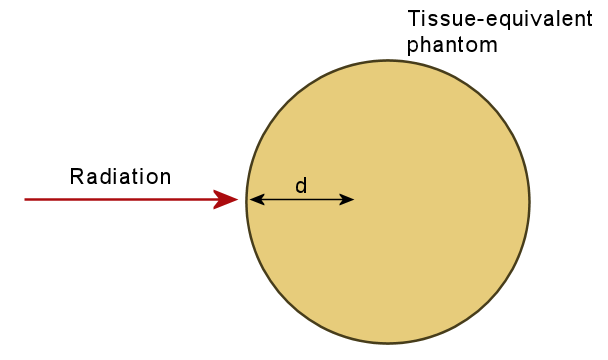Like most Monte Carlo codes, GamBet can perform H*(10) calculations. In this article, I will review the significance and technical background of the calculations. In applications to personnel shielding, it is not sufficient simply to know the radiation field at a location. By radiation field, I mean the fluxes of energetic electrons and photons along with their energy spectra. The critical issue is how do the particles interact with tissue and how does the dose (deposited energy divided by mass) build up inside the organism. A further complication is that the same dose may have different biological effects, depending on the radiation and tissue type. The standard unit of physical dose is the gray (Gy), equal to 1 joule/kg of deposited energy. The unit of biological dose is the sievert (Sv) which also has units of J/kg. The difference is that the biological dose includes weighting factors that depend on the radiation type (Wr) and the tissue type (Wt) to indicate the relative potential for biological harm. Dose values are related by
D(Sv) = D(Gy)*Wr*Wt
The radiation weighting factor is Wr = 1.0 for photons and electrons, so we need not worry about it in GamBet calculations. The tissue weighting factor Wt is difficult to estimate, and therefore there is considerable disagreement about the values. For whole-body irradiation, the convention is to take Wt = 1.0. The implication is that for most shielding calculations at energies of interest for medical applications, sieverts are equivalent to grays.
The critical issue is the dose buildup through interactions with tissue. To standardize measurements and calculations, the ICRU (International Commission on Radiation Units and Measurements) defined the Directional Dose Equivalent, H*(d). The quantity applies to radiation moving predominantly in one direction, such as X-rays outside a radiation shield. A different quantity, Hp (the personnel dose equivalent), applies to approximately isotropic radiation fields, like the time that Mr. Spock was trapped in the Propulsion Chamber.
The ideal calculation or measurement defined by the ICRU uses a 30-cm-diameter sphere of tissue-equivalent plastic with a density of 1 g/cm^3 and a mass composition of 76.2% oxygen, 11.1% carbon, 10.1% hydrogen and 2.6% nitrogen. The quantity H*(d) is the biological dose at a depth d below the surface of the sphere in the direction of the radiation (Figure 1). The most common choice of d is 10.0 mm, hence the term H*(10). The reasoning is as follows. When a flux of gamma rays enters a material, the dose increases moving away from the surface because of the generation of secondary electrons (e.g., Compton electrons). The electrons deposit energy more rapidly than photons. The secondary electron density grows with distance until the production rate equals the absorption rate. At this equilibrium point, the dose reaches a maximum. For gamma rays in the 1 MeV range (typical of radioactive sources) in a material with density 1 gm/cm^3 (e.g., water), the equilibrium depth is a 10.0 mm or less.

Figure 1. Geometry to define the Directional Dose Equivalent.
To conclude, here are a couple practical suggestions for H*(10) calculations in GamBet. First, in defining custom materials, GamBet follows the Penelope convention using the stochiometric composition (the relative number of atoms in an equivalent molecule) rather than mass fractions. To make the conversion, assume that F0, FC, FH and FN are the stochiometric fractions for oxygen, carbon, hydrogen and nitrogen. Because the quantities are relative, we take F0 = 1.00. Using the atomic weights and mass fraction of 0.762 for oxygen, we can determine the other quantities from these equations:
FC*12.011/15.994 = 0.111/0.762
FH*1.00794/15.994 = 0.101/0.762
FN*14.00674/15.994 = 0.026/0.762
Here's the result as it would appear in the Composition section of a GamBet script:
Material
Name TissueEquivalent
Component O 1.0000
Component C 0.1940
Component H 2.1032
Component N 0.0390
Density 1.00
Insulator
End
Finally, note it is not necessary to use a 30 cm sphere of the tissue equivalent material in calculations. Any block of material will give about the same answer, as long as the object has depth and width greater than d.
Another article describes a walkthrough example that gives some good insights into the physics of the H*(10) calculation. The example illustrates several GamBet techniques and new features and provides an opportunity to make comparisons with several other radiation-shielding codes.
LINKS